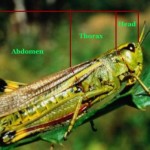
Diagram of grasshopper showing head, thorax and abdomen. Credit: Kelly Gilkerson, Clemson University
Pest identification should be as accurate as possible. Management programs improve significantly with specific knowledge of the pest, its life cycle and behavior. Careful monitoring of species can enable you to detect subtle changes in a complex of pest species.
Example: The displacement of leafminer species by the chrysanthemum leafminer, Liriomyza trifolii, can result in significant problems in leafminer control.
Generalized identifications can lead to control problems.
Example 1: Beet armyworms on some bedding plants like chrysanthemums may not respond to insecticides used for other armyworm species that are more susceptible to commonly used insecticide products due to insecticde tolerance or resistance.
Example 2: Although soft scales like the Florida wax scale on hollies is susceptible to imidacloprid (a neonicotinoid insecticide product), armored scales like the cycad aulacaspis scale are not susceptible to imidaclodrid and are better controlled with another neonicotinoid, dinotefuran.
Pest identification should, at least, be as specific as the identification on the label of the pesticide to be used. If “caterpillars” are damaging an oak tree, a product for controlling “caterpillars” may be used unless the label specifically lists “tent caterpillars.” Sometimes the actual common or scientific name of the pest is mentioned on the label, such as “forest tent caterpillar,” signifying that the product can be used only for this specific pest. In other instances a more general name may be listed, such as “budworm,” which requires some interpretation as to whether “spruce budworm” or “tobacco budworm” was intended.
Next >> IPM Concepts: Damage Recognition
Related
- Diagnosing Insect and Mite Damage
- Good Bug or Bad Bug?
- Beneficial Insects
- Insect Pests of Ornamentals
- Insect Pests of Turfgrass
- IPM Practices
- History of IPM
- Types of Pest Control
- Monitoring and Identification Techniques for Insect Pests – eXtension
